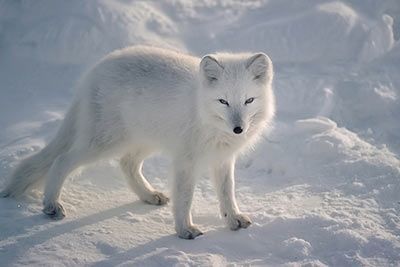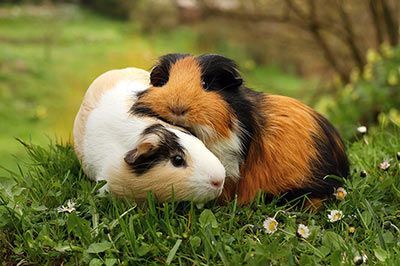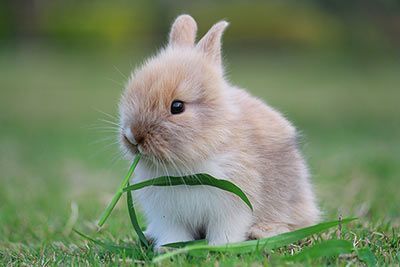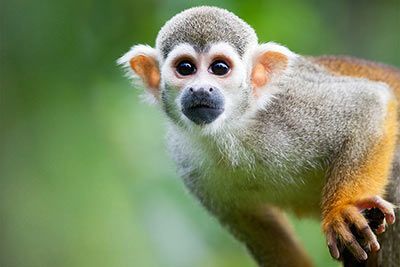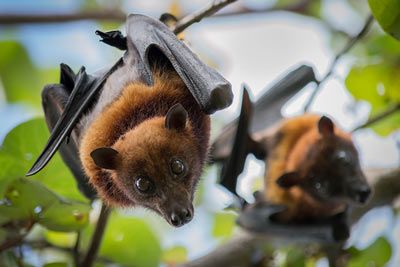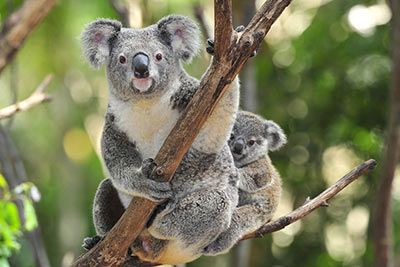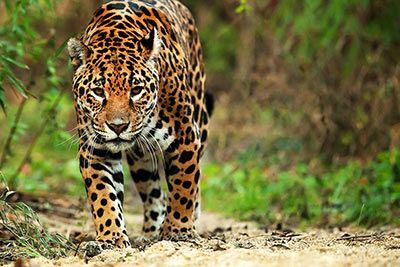Gorilla
Gorilla Facts
| Size | 50-68 inches (125-175 cm) |
| Speed | Up to 25 mph (40 km/h) |
| Weight | 154-507 pounds (70-230 kg) |
| Lifespan | 35-40 years |
| Food | Plants, roots, sprouts |
| Predators | Leopards, crocodiles |
| Habitat | Africa |
| Order | Primates |
| Family | Great apes |
| Scientific name | Gorilla |
| Characteristics | Great ape with strong forehead and long arms |
Main Characteristics
Gorillas are the world's largest primates. They primarily feed on leaves and are famous for beating their chest with cupped hands. They are often portrayed as aggressive, but they're actually very peaceful animals.
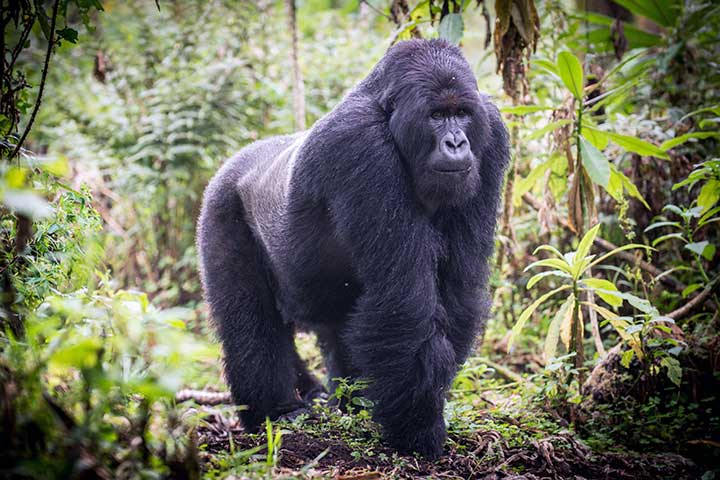
Species
Gorillas are part of the great ape family. There are two species: the western and the eastern gorilla. Both have subspecies.
- Western Gorilla subspecies: Western Lowland Gorilla, Cross River Gorilla
- Eastern Gorilla subspecies: Eastern Lowland Gorilla, Mountain Gorilla
Distribution and Habitat
Gorillas live in Africa. They're primarily found in Cameroon, the Congo, Equatorial Guinea, Nigeria, Gabon, Uganda, and Rwanda. They prefer forests, mountain forests, and swamps as their habitats.
Life Style
Gorillas are active during the day. They spend most of their time searching for food, eating, resting, finding a mate, and taking care of their offspring. They live in small groups, forming communities ranging from 4 to 40 individuals depending on the species. They communicate with their conspecifics through vocalizations, facial expressions, and body postures. The leader of a group is always a silverback, which is the oldest individual in the group.
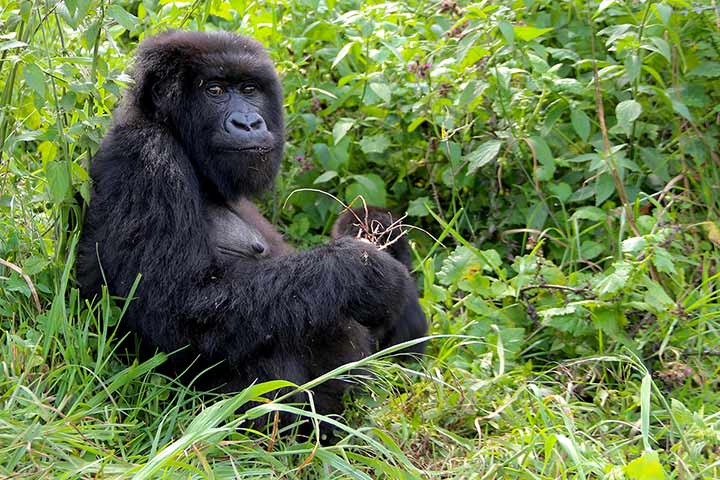
Anatomy and Appearance
Size and Weight
Gorillas are large and strong primates. When standing upright, they measure between 50-68 inches (125-175 cm). Female gorillas are smaller and lighter, reaching heights of 50-60 inches (125-150 cm) and weighing 154-242 pounds (70-110 kg). The male gorillas, on the other hand, have a size range of 55-68 inches (140-175 cm) and weigh between 286-507 pounds (130-230 kg). The largest gorilla ever recorded was 76 inches (195 cm) tall with arms spanning 106 inches (270 cm). The heaviest gorilla weighed 588 pounds (267 kg). In captivity, these animals can become even heavier due to stress and lack of exercise.
Arms and Legs
Gorillas have very long arms that can reach length of 78-108 inches (200-275 cm). They're significantly longer than their legs. Their arms are equipped with broad hands and large thumbs. Their feet are wide and robust.
Fur
Gorillas have short, dark fur. Depending on the species, it can be dark gray, dark brown or black. As male gorillas grow old, the fur on their backs turns gray. Such an animal is also called a “silverback”. There are also white gorillas, so-called albinos. But these animals are very rare. They suffer from sensitivity to light, reduced visual acuity, are often deaf and have less chance of survival in the wild.
Skin
Gorillas have no hair on their ears, palms, or soles of their feet. Her dark, leathery skin can be seen there. In older males, the chest is sometimes hairless.
Head
Forehead
Gorillas have a high-domed head with a broad, bulging forehead.
Eyes
Gorillas have very small eyes with a significant brow ridge above their eyes. This is why they always look a bit grim.
Ears
Of all animals, gorillas have the largest eardrums - even though they have such small ears. The eardrum measures 0.15 inch² (97 mm²). A human eardrum only measures 0.096 inches² (62 mm²).
Nose
Gorillas have a broad, but very flat nose with large nostrils. Biologists look at the gorillas` noses to identify them. No two noses look the same!
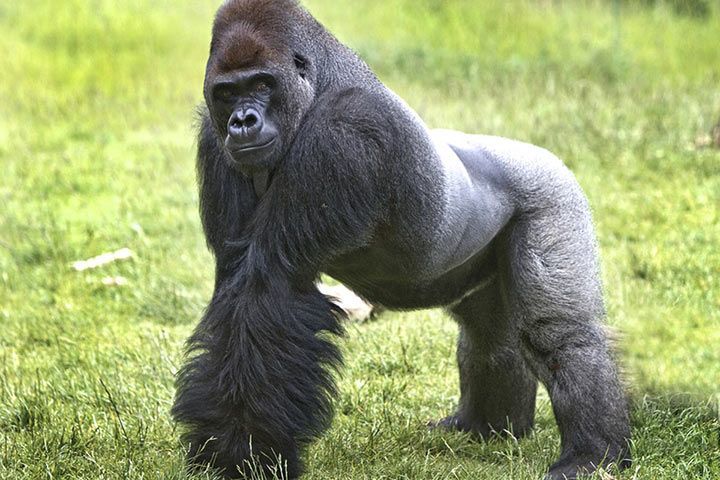
Diet
Plants
Gorillas are herbivores. They feed on plants, roots and sprouts. They need 40-66 pounds (18-30 kg) of food daily. Sometimes they also eat fruit and small insects such as termites.
Feces
Gorillas often eat their own feces. They can't digest their plant-based food well. Most nutrients pass through the intestines unprocessed and out. When they eat their feces, they are able to absorb the nutrients they were previously missing out on. This sounds gross to us humans, but to them it is a very intelligent strategy.
Water
Gorillas don't drink water, because the plants contain sufficient amounts of liquid.
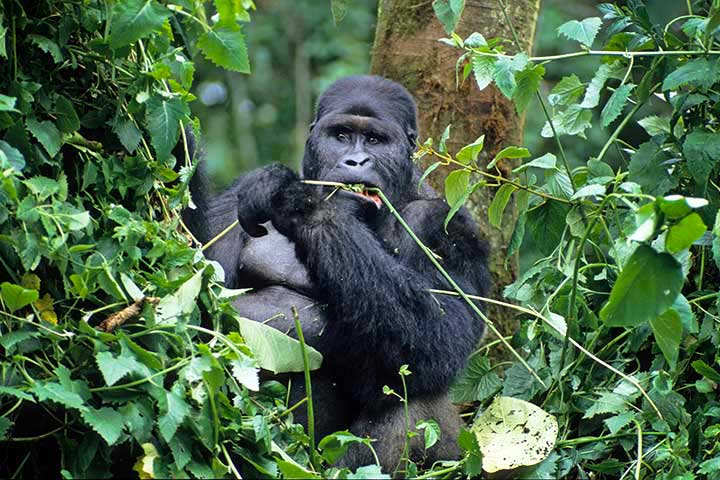
Nature
Are Gorillas Dangerous?
Most people think that gorillas are aggressive and attack and kill people. An adult male huffing and drumming its chest can actually be frightening. Movies like “King Kong” have also increased fear of these animals. However, they're very peaceful. That is why they are also called “gentle giants”. Of all great apes, they are considered to be a particularly reserved, calm and social species.
Why Do Gorillas Fight?
Gorillas fight for a higher rank within the group or to defend themselves against intruders. Threatening gestures are usually enough to intimidate a fellow species. Real fights rarely happen.
How Do Gorillas Fight?
When gorillas fight, they use their teeth, hands and feet.
Do Gorillas Attack Humans?
Gorillas are generally peaceful creatures, but if they feel threatened or cornered, they can become quite dangerous. They will use all their strength to defend themselves, especially older males. However, most of the time, their response is just a show of force with loud screams and mock attacks.
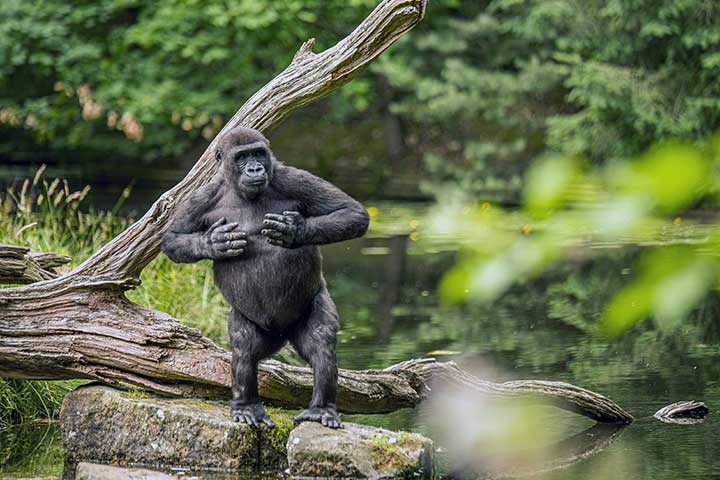
Behavior
Communication
To communicate with their fellow species, gorillas use sounds, facial expressions and body postures.
Why Do They Drum on Their Chests?
Gorillas are most famously known for their behavior of drumming on their chests, which can be heard from a distance of nearly 0.62 miles (1 km). In the past, it was believed that only males would drum - to demonstrate to others who is the “coolest”. Today we know that female animals also drum. Gorillas drum to greet each other or to let others know where they are.
Climbing
Gorillas are very good at climbing. Despite being so large and heavy, they can climb trees up to 130 feet (40 meters) high! However, they don't use their arms to swing from branch to branch like chimpanzees. They prefer to wedge themselves between branches. The mountain gorilla climbs the least among all gorilla species.
Swimming
Gorillas can't swim.
Nest Building
Among mammals, the gorillas are the largest animals that build nests. They don’t do it for their offspring, which is mostly carried on their backs. They build nests to have a nice and cozy place to sleep and rest. The nests usually consist of leaves, measure about 3 feet (1 meter) in diameter and are newly constructed every day.
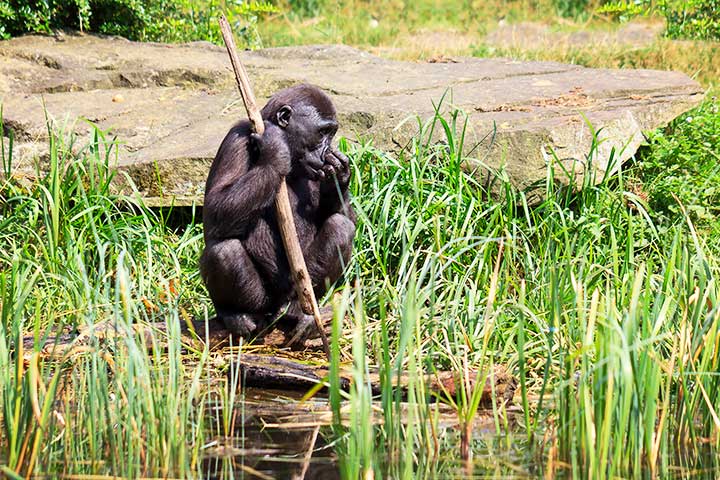
Abilities and Senses
Intelligence
Tool Use
Gorillas are among the few animals that are known to use tools. They use branches as makeshift measuring tools. By inserting them into bodies of water, they determine its depth. That's clever, because after all they can't swim. They also use wooden planks to get across swampy soil safely. That's pretty clever because it means they can get safely to the other side without sinking. Read more about tool use and animal intelligence.
Locomotion
Gorillas walk on their knuckles. This means that they clench their hands into a kind of fist when they run. Their fingers only make contact with the ground at the second and third knuckles. By the way, chimps also walk on their knuckles.
Strength
Their bite force is two times stronger than that of a lion.
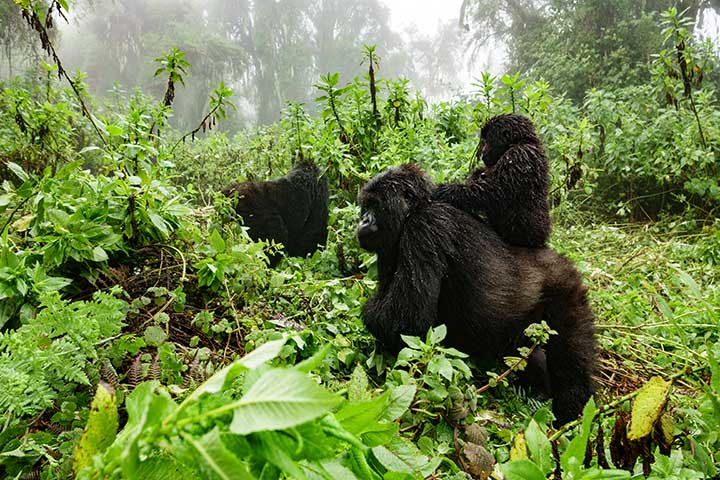
Life Expectancy
Gorillas live to be 35-40 years old in the wild and up to 50 years old in captivity.
Enemies and Threats
Natural Enemies
Adult gorillas hardly have any natural predators. Only leopards can be fatal to small, vulnerable babies.
Human Impact
Gorillas are threatened with extinction. The reason for this is humans. The animals are killed or hunted by poachers for food (so-called “bushmeat”). Additionally, their habitats are destroyed as more and more forests are cleared. These areas are then used for cocoa, palm oil and rubber plantations, as well as grazing land for livestock.
Conservation Status
It is estimated that there are only 365,000 animals left in total: 360,000 of the western lowland gorilla, 250-300 of the cross river gorilla, 3,800 of the eastern lowland gorilla and 1,000 of the mountain gorilla. However, these numbers are very inaccurate. Why? It is very difficult to count the animals because they hide in the jungle. Counting is also challenging due to the constant tensions among people that live nearby. The situation is often too dangerous for biologists.
Importance for the Ecosystem
Gorillas are very important for the balance in nature. They don't seem to do much more than eat all day, but that's exactly what helps nature. By consuming the seeds of trees and dispersing them through their droppings, they play a vital role in the growth of new trees. While moving through the jungle they also destroy young plants so that more light falls on the dark jungle floor. This allows other plants to grow healthy and strong.
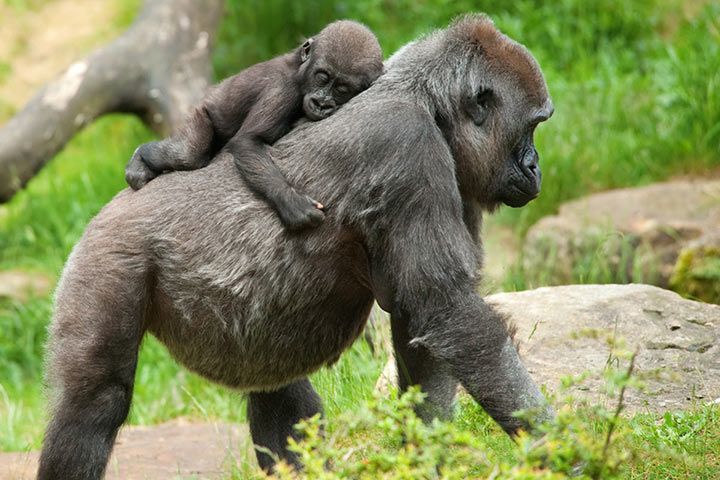
Reproduction
Mating
In gorillas, only the male has the right to mate with the females of the group. When a female is ready, she will show it by approaching the male and making eye contact.
Gestation Period
Gorillas have the longest gestation period of all primates. It lasts 8-9 months.
Offspring
Baby gorillas are born weighing 4-5 pounds (2 kg). They're nursed for 3-4 years and are fully grown at an age of 6-10 years. However, they only reproduce when they are 9-15 years old.
Evolution and Discovery
Gorillas were likely discovered as early as 440 BC. However, it was not until 1847 that a naturalist described the species scientifically for the first time. The way of life of the gorillas became known with Dian Fossey. She was a zoologist and behaviorist. In 1967 she began living with the animals and was accepted as a group member. Decades of research followed. She wrote a book so that people could learn not to be afraid of animals. The title of her famous novel is “Gorillas in the Mist”.
Fun Facts
Where Does the Name Come From?
„Gorilla“ is a Greek word meaning "tribe of hairy women".
Which Other Primates Live in Africa?
Apart from gorillas, chimpanzees, mandrills and baboons live on the African continent. Lemurs have their "residence" on the island of Madagascar off the southeast coast of Africa.
The Most Famous Gorillas
Koko
The world's most famous gorilla was a female named Koko. She knew human sign language and even owned pets.
Snowflake
Another very famous gorilla was Snowflake. He was the world's only known albino gorilla to date. His fur was white and his skin was pink. He lived in a zoo in Barcelona and died at the age of 40 - which is about 80 human years old.
The Gorilla Is Related To:
Animals in the Same Biome:
Related Articles:
Recommended Videos:













 Endangered Animal Species
Endangered Animal Species